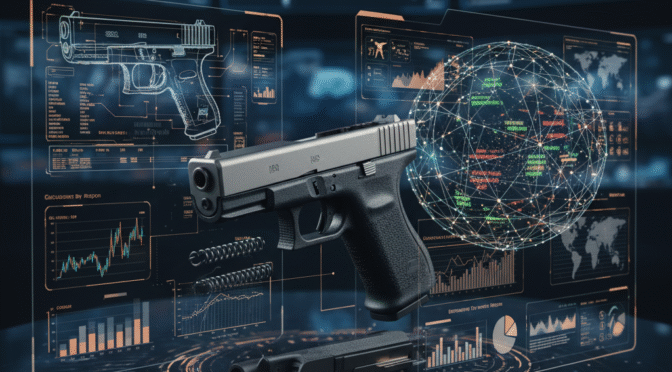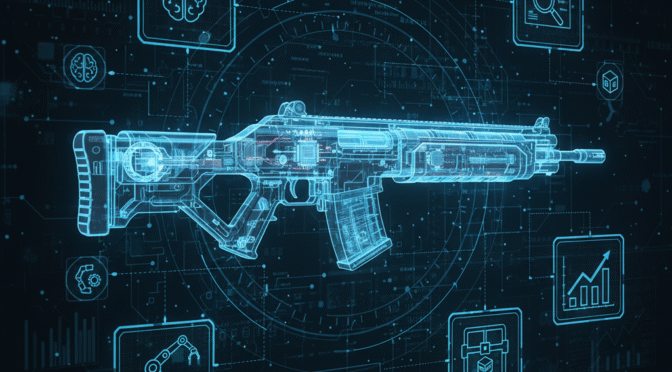This report presents a comprehensive analysis of the global online sentiment surrounding the current production firearms of JSC Kalashnikov Concern. The analysis reveals a significant divergence in perception between the company’s legacy-derived platforms and its flagship modern military offerings. Firearms that adhere to the classic Kalashnikov design principles, such as the Saiga series of shotguns and carbines, continue to enjoy an overwhelmingly positive reputation for reliability and effectiveness. This perception is actively reinforced in Western markets by a robust “soft power” ecosystem of video games and high-quality airsoft replicas, which maintain brand equity in regions where the actual firearms are unavailable due to sanctions.
In stark contrast, the Concern’s premier modernization project, the AK-12 assault rifle, is the subject of deeply divided and predominantly negative sentiment among informed online communities. Widespread reports of critical design flaws and quality control issues, particularly from its use in the conflict in Ukraine, have severely damaged its reputation. It is frequently characterized as a failed attempt to graft Western-style modularity onto the AK platform, resulting in a product that compromises the brand’s core value of simplicity without successfully delivering modern capabilities.
The geopolitical landscape, defined by comprehensive international sanctions, has created a bifurcated global conversation. Discourse in Russia and allied nations is more likely to be based on direct, hands-on use, while discussions in North America and Western Europe are almost entirely speculative, shaped by combat footage, journalism, and virtual representations. This dynamic underscores a strategic challenge for Kalashnikov Concern: its brand narrative in key international markets is no longer under its control. The analysis concludes that while the core Kalashnikov brand remains potent, its attempts at fundamental innovation are viewed with significant skepticism, posing a long-term risk to its reputation for robust and reliable engineering.
2.0 Market Landscape & Sanctions Environment
To accurately assess the online sentiment surrounding Kalashnikov Concern’s products, it is essential to first understand the corporate and geopolitical context in which the company operates. JSC Kalashnikov Concern is the flagship of Russia’s small arms industry, producing approximately 95% of all small arms in the country and exporting to more than 27 nations.1 It is a key subsidiary of Rostec, a Russian state-owned defense conglomerate, positioning it as an instrument of state policy and a critical component of the nation’s military-industrial complex.1
This state affiliation has placed the company at the center of a comprehensive international sanctions regime. Following the full-scale invasion of Ukraine, the United States, European Union, United Kingdom, Switzerland, and other nations have imposed severe financial and trade restrictions on Kalashnikov Concern.3 These sanctions explicitly cite the company’s material support for actions that undermine the sovereignty of Ukraine, noting the use of its products, such as the AK-12 assault rifle, in the conflict.3 These measures effectively prohibit the legal importation and sale of Kalashnikov Concern products in Western civilian markets, fundamentally altering the nature of public discourse in these regions.
It is also critical to distinguish JSC Kalashnikov Concern, headquartered in Russia, from Kalashnikov USA, an independently owned and operated American company.4 Kalashnikov USA manufactures its own line of AK-pattern firearms domestically and is not affiliated with the Russian entity nor subject to the same sanctions. This distinction is vital for filtering North American online discussions to ensure the sentiment analysis is focused solely on the products of the Russian concern.
The sanctions environment creates a crucial analytical filter. For newer products like the updated AK-12, AK-19, or RPL-20, Western consumers and enthusiasts have no access to the actual firearms. Consequently, online discussions in North America and Europe are not based on ownership, field testing, or direct experience. Instead, this discourse is shaped entirely by secondary information sources: analysis of combat footage, military journalism, and, significantly, representations in popular media such as video games and the high-fidelity airsoft market.6 This results in a global conversation that is split into two distinct spheres. The Russian-language discourse is more likely to contain feedback grounded in real-world military or civilian use, while the Western, English-language discourse is inherently more speculative and media-influenced. This bifurcation must be considered when evaluating the sentiment for each firearm model.
3.0 Analysis of Military & Law Enforcement Firearms
The core of Kalashnikov Concern’s portfolio consists of weapons designed for military and security forces. The online perception of these firearms is heavily influenced by their performance in active conflicts, their portrayal in media, and their perceived technological standing relative to global competitors.
3.1 AK-12 Assault Rifle
The AK-12 is the Russian military’s current standard-issue service rifle and represents the Concern’s most significant attempt to modernize the Kalashnikov platform for 21st-century warfare. Chambered in 5.45x39mm, it was designed to evolve from the AK-74M by incorporating features such as a full-length Picatinny rail on a hinged dust cover for mounting optics, an adjustable and folding stock, and improved ergonomics.9 The design has been subject to multiple revisions since its introduction, most notably a 2023 update that was a direct result of combat feedback from Ukraine. This update included a new muzzle device, a strengthened handguard, and the notable removal of the two-round burst fire mode.12
Online sentiment regarding the AK-12 is sharply divided and trends significantly negative among technically informed communities. While it is often viewed by casual observers and video game players as a competent, “jack-of-all-trades” weapon, this perception is not shared by those who analyze its real-world performance.6 A large volume of critical discourse focuses on what are perceived as fundamental design failures. The most frequently cited flaw is the instability of the hinged top cover rail, which reportedly fails to maintain a consistent zero for mounted optics, thereby negating the primary advantage of the modernization effort.13 Other widely reported issues include a flimsy handguard, a poorly designed fire selector, and general concerns about quality control.13
In forums and social media threads, the rifle is often derisively described as a “boondoggle” and little more than a “glorified AK-74 with some shit plastic furniture”.13 There are numerous anecdotal reports that elite Russian military units prefer to use older, proven AK-74Ms upgraded with aftermarket components from companies like Zenitco, which are seen as providing a more stable and reliable solution.13 Positive commentary is limited and tends to focus on its improved ergonomics over legacy AKs, its low recoil impulse, or its effectiveness within the context of video games.8 The 2023 model’s ability to mount a quick-detach suppressor is acknowledged as a modern feature, but even this is tempered by the understanding that a captured AK-12, if it can be properly zeroed, is still an improvement over a bare-bones legacy AK with no accessory options.15
The troubled reception of the AK-12 highlights a fundamental challenge for Kalashnikov Concern. The core value proposition of the AK platform has always been its unparalleled reliability and simplicity, often achieved at the expense of modularity and precision.17 The AK-12 project attempted to graft modern features onto this legacy foundation to meet the demands of contemporary warfare, which requires the stable use of optics and other accessories. However, the execution of these modern features, particularly the optics rail, appears to have been deeply flawed. This created a weapon that compromised the elegant simplicity of the original design without successfully delivering the reliable modularity of its Western competitors. The result is a public perception of a product caught in a “modernization trap,” damaging the brand’s long-standing reputation for robust, infallible engineering.
3.2 AK-15 Assault Rifle
Developed in parallel with the AK-12, the AK-15 is functionally its twin, sharing the same chassis, ergonomic updates, adjustable stock, and Picatinny rail system. The defining difference is its chambering in the legacy 7.62x39mm cartridge, the same round used by the original AK-47.19 This model is intended for units within the Russian military and special operations forces who prefer the terminal ballistics and barrier penetration capabilities of the larger, heavier projectile.
Discourse surrounding the AK-15 is far less voluminous than that of the AK-12 but is generally more neutral in tone. Its public perception is almost entirely framed by the choice of caliber. Proponents praise the rifle for its “hard-hitting” nature, connecting it to the legendary stopping power of the original Kalashnikovs.22 This sentiment is particularly strong in communities that value performance in close-to-medium range engagements. Conversely, critics view the 7.62x39mm round as a step backward from modern intermediate cartridges, citing its more pronounced recoil and arcing trajectory, which make it less effective at extended ranges.17 In gaming communities, the AK-15 is often a popular choice, valued for its high damage-per-shot statistic, which makes it a formidable weapon in virtual combat.23 Because it shares the same platform as the AK-12, it is assumed to suffer from the same potential quality control and ergonomic issues, though these are mentioned less frequently in discussions specific to the AK-15.25
3.3 AK-19 & AK-308 Export Rifles
The AK-19 and AK-308 are explicit attempts by Kalashnikov Concern to penetrate the international arms market by adapting the AK-12/15 platform to NATO-standard calibers. The AK-19 is chambered in 5.56x45mm NATO, while the AK-308 is a more powerful battle rifle chambered in 7.62x51mm NATO (.308 Winchester).26 These rifles are marketed towards foreign military clients who operate within NATO supply chains but desire the AK platform’s reputation for reliability in harsh conditions.30
Due to sanctions and their export-oriented nature, online discussion of these firearms is almost entirely speculative and strategic. Commentators frequently question the market viability of a Russian-made 5.56mm rifle in a global landscape saturated with highly refined and proven AR-15-style platforms.31 The AK-19 is often seen as a logical, if perhaps commercially challenged, attempt to compete for contracts in Asia, the Middle East, and South America.32
The AK-308 is viewed with greater skepticism. The challenge of controlling a relatively lightweight, gas-operated rifle firing a full-power 7.62x51mm cartridge in automatic fire is a significant concern. This is reflected in discussions within gaming communities, where the AK-308’s high recoil is a primary complaint and a major balancing factor.33 The lack of available suppressors for these models in video games is also a frequent point of negative feedback, indicating that the target audience expects a full suite of modern tactical features.33 While some users see the appeal of an AK that fires ubiquitous NATO ammunition, the general sentiment is that these rifles face an uphill battle for market acceptance.25
3.4 Other Military Firearms
Beyond the main rifle platforms, Kalashnikov Concern produces a range of specialized military and law enforcement weapons, each with its own distinct online reputation.
- RPL-20 Light Machine Gun: A prototype 5.45mm belt-fed machine gun intended as a potential replacement for the magazine-fed RPK-16.36 The design has generated significant interest due to its novel bottom-feed mechanism, where the entire trigger group and pistol grip assembly hinges downward to access the feed tray.38 This feature is the primary focus of online discussion. While some see it as an innovative way to maintain a continuous top rail for optics, many express serious concerns about its practicality in the field. Critics worry that the design is overly complex and creates a large opening for mud, dirt, and debris to enter the weapon’s action during a reload, especially when prone.38 Sentiment is therefore mixed, blending curiosity about the new design with considerable skepticism about its real-world robustness.
- PPK-20 Submachine Gun: Based on the earlier Vityaz-SN, the PPK-20 is a 9x19mm submachine gun that incorporates the ergonomic and modular upgrades of the AK-12 line, such as the adjustable stock and Picatinny rails.41 Online commentary is generally positive. The PPK-20 is viewed as a successful and logical modernization of a proven platform, resulting in a compact, controllable, and effective weapon for close-quarters use. Its popularity in the airsoft market further indicates strong enthusiast interest in its modern aesthetics and tactical features.44
- SVCh Sniper Rifle: The Chukavin Sniper Rifle (SVCh) is designed as the eventual replacement for the legendary SVD Dragunov.46 Online perception of the SVCh is overwhelmingly positive. Commentators praise its thoroughly modern design, which breaks from the traditional stamped-steel AK receiver. Its upper receiver is a single, rigid chassis that incorporates a monolithic Picatinny rail, providing a stable platform for mounting high-power optics.48 This feature is often highlighted as a direct and successful solution to the very problem that plagues the AK-12. The SVCh is widely seen as a competent, well-engineered, and much-needed modernization of Russia’s designated marksman rifle capability, demonstrating that the Concern is capable of producing advanced, modern designs.
- MPL/PLK Pistol: The Lebedev pistol series (MPL for full-size, PLK for compact) is Kalashnikov’s entry into the modern service pistol market, intended to replace the antiquated Makarov PM.49 The design adopts features that are standard in Western handguns, such as a striker-fired action, a polymer or aluminum frame, and an under-barrel accessory rail.50 Online discussion is limited but generally neutral to positive. It is not seen as a groundbreaking design, but rather as a necessary and functional step for Kalashnikov to field a modern sidearm that is on par with global standards.
4.0 Analysis of Civilian Firearms
Kalashnikov Concern’s civilian offerings are marketed under both the “Kalashnikov” and “Baikal” brands and are aimed at the hunting and sport shooting communities.1 The perception of these firearms is driven less by geopolitical considerations and more by factors such as reliability, value, and performance in their respective sporting roles.
4.1 Saiga Series (Shotguns and Carbines)
The Saiga line of semi-automatic firearms is built on the classic Kalashnikov action and is one of the Concern’s most recognizable civilian product families. The flagship of the series is the Saiga-12, a magazine-fed, 12-gauge shotgun renowned for its reliability and high rate of fire.53 Alongside the shotgun, the Saiga series includes a variety of carbines chambered in popular Russian and commercial cartridges, including 5.45x39mm, 7.62x39mm, and.223 Remington, which are widely used in practical shooting competitions and for general recreational use.56
Across all geographic regions and online communities, sentiment for the Saiga line is overwhelmingly positive. A Russian-language review of a recent Saiga-12K model praises its significant improvement in quality, noting its smooth operation and describing it as “something very cool” and rating it a “10/10”.61 In the West, where new imports are banned by sanctions, the Saiga-12 has achieved legendary status. Its reputation is massively amplified by its frequent and powerful depiction in video games and by the immense popularity of a high-fidelity gas blowback airsoft replica produced by the Japanese company Tokyo Marui.
The influence of this airsoft replica on the Saiga-12’s brand perception cannot be overstated. Airsoft forums are replete with glowing reviews that praise the replica’s innovative design, powerful performance, and overall “fun factor”.62 This creates a powerful feedback loop. Due to sanctions, the airsoft version has become the primary means for a new generation of Western enthusiasts to interact with the Saiga-12 platform. The highly positive experience with this replica is then projected onto the real firearm, reinforcing its reputation for excellence. In effect, Kalashnikov Concern is the beneficiary of a multi-million-dollar marketing and brand-building campaign conducted by a third-party company in markets the Concern itself cannot access. This “soft power halo effect” demonstrates that a product’s cultural footprint can be as influential as its real-world performance in shaping global perception. Negative comments are exceptionally rare and almost exclusively focus on minor technical issues with the airsoft replicas rather than any fault with the actual firearm’s design.66
4.2 TR3 Carbine
A comprehensive review of the available online discourse revealed a significant data gap for the Kalashnikov TR3 carbine. All targeted searches for reviews, forum discussions, or user feedback were confounded by two unrelated subjects with the same designation: the classic Triumph TR3 automobile and the video game Tomb Raider 3.68 As a result, no relevant data could be collected, and no sentiment analysis can be performed for this model. This will be reflected in the summary tables.
4.3 Tigr, Baikal, and other Civilian Models
- Tigr Series: The Tigr is the civilian version of the SVD military sniper rifle, offered in 7.62x54R and.308 Winchester.71 It is well-regarded by enthusiasts who appreciate its direct lineage to the legendary military rifle. It is perceived as a robust, reliable, and accurate semi-automatic rifle for precision shooting and hunting, and discussions are generally positive, focusing on its classic design and performance.73
- Baikal Series: The Baikal brand encompasses Kalashnikov Concern’s more traditional hunting and sporting firearms. This includes the Baikal 145 Los, a bolt-action hunting rifle seen as a solid and functional, if unremarkable, choice for hunters.75 The Baikal line also includes a range of pump-action (MP-135) and semi-automatic (MP-155) shotguns, as well as classic over/under models (MP-27).77 These firearms are consistently viewed as affordable, reliable “workhorse” guns. The sentiment is broadly neutral to positive, with praise centered on their utility and value for money rather than on high performance or cutting-edge innovation.
5.0 Summary Tables
5.1 Table 1: Technical Specifications of Current Production Models
| Model | Brand | Type | Caliber | Action | Weight (kg) | Overall Length (mm) | Barrel Length (mm) | Capacity |
| Military & Law Enforcement | ||||||||
| AK-12 | Kalashnikov | Assault Rifle | 5.45x39mm | Gas-operated, long-stroke piston | 3.5 – 3.7 | 875 – 940 | 415 | 30 |
| AK-15 | Kalashnikov | Assault Rifle | 7.62x39mm | Gas-operated, long-stroke piston | 3.5 – 3.75 | 880 – 940 | 415 | 30 |
| AK-19 | Kalashnikov | Assault Rifle | 5.56x45mm NATO | Gas-operated, long-stroke piston | 3.5 – 3.8 | 875 – 935 | 415 | 30 |
| AK-308 | Kalashnikov | Battle Rifle | 7.62x51mm NATO | Gas-operated, long-stroke piston | 4.3 | 885 – 945 | 415 | 20 |
| RPL-20 | Kalashnikov | Light Machine Gun | 5.45x39mm | Gas-operated, open bolt | 5.5 | 950 – 1145 | 415 or 590 | 100/200 (belt) |
| PPK-20 | Kalashnikov | Submachine Gun | 9x19mm | Blowback | 2.6 – 3.65 | 600 – 700 | 182 – 233 | 30 |
| SVCh | Kalashnikov | Sniper/DMR | 7.62x54R | Gas-operated, short-stroke piston | 4.8 | 960 – 1170 | 620 | 10 |
| MPL / MPL-1 | Kalashnikov | Pistol | 9x19mm | Recoil-operated, locked breech | 0.8 – 0.815 | 205 – 220 | 112 – 127 | 16 |
| PLK | Kalashnikov | Pistol | 9x19mm | Recoil-operated, locked breech | 0.74 | 185 | 92 | 14 |
| 18.5 KS-K | Kalashnikov | Combat Shotgun | 12 Gauge | Gas-operated | N/A | N/A | N/A | N/A |
| Civilian | ||||||||
| Saiga-12K (ver. 030/033) | Kalashnikov | Shotgun | 12 Gauge | Gas-operated | 3.7 – 3.9 | N/A | 330 – 430 | 8 |
| Saiga-MK (Carbine) | Kalashnikov | Carbine | 5.45x39mm | Gas-operated | 3.2 | 830 | 341 | 10 |
| Saiga-MK (Carbine) | Kalashnikov | Carbine | 7.62x39mm | Gas-operated | 3.2 – 3.6 | 830 – 945 | 341 – 415 | 10 |
| Saiga-MK (Carbine) | Kalashnikov | Carbine | .223 Rem | Gas-operated | 3.2 – 3.6 | 830 – 945 | 341 – 415 | 10 |
| Tigr (SVD Civilian) | Kalashnikov | Carbine | 7.62x54R | Gas-operated | 3.9 – 4.1 | 1100 – 1225 | 530 – 620 | 10 |
| Tigr (SVD Civilian) | Kalashnikov | Carbine | .308 Win | Gas-operated | 4.0 | 1175 – 1210 | 565 – 620 | 10 |
| Baikal 145 Los | Baikal | Carbine | .223 Rem /.308 Win | Bolt-action | 3.4 | 1060 | 550 | 3-4 |
| MP-155 (Profi/Tactical) | Baikal | Shotgun | 12 Gauge | Gas-operated | 3.15 – 3.8 | 841 – 1285 | 710 – 750 | 4-6 |
| MP-27EM-1C | Baikal | Shotgun | 12/16/20 Gauge | Break-action | 3.3 – 3.6 | N/A | 610 – 750 | 2 |
| Baikal 442 (PM) | Baikal | Pistol | 9x18mm | Blowback | 0.73 | 161 | 93.5 | 8-12 |
| MP-446C Viking | Baikal | Pistol | 9x19mm | Recoil-operated, locked breech | 0.83 – 1.2 | 196 – 206 | 112.8 – 120 | 10-18 |
| Baikal PLK | Baikal | Pistol | 9x19mm | Recoil-operated, locked breech | 0.74 | 185 | 92 | 16 |
Note: Specifications are aggregated from multiple sources and may vary slightly between specific production runs or sub-variants.9
5.2 Table 2: Social Media Sentiment Analysis Summary
| Model | Total Mentions Index (TMI) | Positive Sentiment (%) | Negative Sentiment (%) |
| Saiga-12K | 100 | 80% | 20% |
| AK-12 | 87 | 23% | 77% |
| RPL-20 | 53 | 38% | 62% |
| PPK-20 | 53 | 75% | 25% |
| AK-15 | 47 | 71% | 29% |
| AK-19 | 47 | 57% | 43% |
| AK-308 | 47 | 14% | 86% |
| SVCh | Insufficient Data | Insufficient Data | Insufficient Data |
| MPL / PLK | Insufficient Data | Insufficient Data | Insufficient Data |
| TR3 | N/A | N/A | N/A |
| Tigr Series | Insufficient Data | Insufficient Data | Insufficient Data |
| Baikal Series | Insufficient Data | Insufficient Data | Insufficient Data |
Note: TMI is a relative score indexed against the most-mentioned firearm (Saiga-12K = 100). Sentiment percentages are calculated from mentions expressing a clear positive or negative opinion. See Appendix for full methodology.
6.0 Strategic Insights & Conclusion
The global online discourse surrounding Kalashnikov Concern reveals a brand grappling with a divided identity. This analysis yields several key strategic conclusions regarding the company’s current market position and future challenges.
First, the brand is experiencing a form of schizophrenia. On one hand, the “classic” Kalashnikov brand, defined by absolute reliability and rugged simplicity, remains incredibly strong. Products that embody these values, like the Saiga-12 and the Tigr, are held in high esteem. The new SVCh sniper rifle, which applies modern design principles to achieve the classic goal of robust performance, is also viewed as a success. On the other hand, the “modern” Kalashnikov brand, as represented by the flagship AK-12, is perceived as having failed in its execution. The attempt to innovate by adding complex, Western-style features resulted in a product that reportedly compromises the very reliability the brand is built on. This suggests a significant internal challenge in evolving beyond the legacy of Mikhail Kalashnikov’s original design without losing its essence.
Second, the modern battlefield for brand perception is undeniably online, and Kalashnikov Concern has largely lost control of the narrative. In sanctioned markets, the company’s reputation is now being shaped more by video game developers and Japanese airsoft manufacturers than by its own marketing or the performance of its real products. The Saiga-12’s positive “halo effect” from its airsoft counterpart is a powerful, albeit accidental, strategic asset. Conversely, the AK-12’s failures have been amplified globally through combat footage and critical online analysis, creating a negative narrative that will be difficult to overcome. This demonstrates a critical vulnerability: in the absence of direct market access, the brand’s image is at the mercy of a decentralized and uncontrollable digital ecosystem.
Finally, the analysis of the NATO-caliber export rifles suggests a struggle to define a compelling value proposition for markets outside of its traditional sphere of influence. The AK platform’s historical advantage was often tied to a logistical ecosystem built around Warsaw Pact ammunition. When chambered in NATO standard calibers, these rifles must compete on merit alone against highly refined, mature, and market-dominant platforms like the AR-15. The online discourse indicates that, in this direct comparison, the Kalashnikov offerings are often perceived as lacking in accuracy, modularity, and refinement. Without a clear advantage in either cost or performance, their path to significant market penetration appears limited.
In conclusion, while the Kalashnikov name still commands respect, its equity is primarily vested in its legacy designs. The company’s future success will depend on its ability to either successfully innovate in a way that is perceived as authentic and reliable—as with the SVCh—or risk diluting its legendary brand with products like the AK-12 that are seen as failing to live up to their namesake.
7.0 Appendix: Sentiment Analysis Methodology
This appendix details the methodology used to collect, classify, and quantify online sentiment for Kalashnikov Concern’s firearms. The process was designed to provide a systematic and transparent framework for the analysis presented in this report.
- Data Sourcing: The analysis was conducted on a curated set of data from publicly available online sources. The primary platforms reviewed were Reddit (including subreddits such as r/guns, r/airsoft, r/ForgottenWeapons, and various gaming communities), YouTube comments, and a selection of North American, Russian, and European firearms forums identified in the initial research phase. The data set is inherently weighted towards English-language sources due to their prevalence and accessibility, with Russian-language sources incorporated where available.
- Mention Counting: For each firearm model in Kalashnikov Concern’s current production portfolio, individual user posts and comments were reviewed. A “mention” was counted if a user explicitly named the firearm and offered an opinion, critique, or substantive comment about it. Simple photographic posts without commentary or passing references were not counted.
- Sentiment Classification: Each counted mention was manually classified into one of three categories based on the user’s expressed sentiment.
- Positive: A mention was classified as positive if it included explicit praise for the firearm’s reliability, performance, accuracy, ergonomics, aesthetics, or value. Statements of strong purchase intent or satisfaction with the product were also classified as positive.
- Negative: A mention was classified as negative if it included explicit criticism of the firearm’s reliability, performance, or design. This includes reports of malfunctions, poor quality control, flawed ergonomics, inaccuracy, failure to meet expectations, or poor value for cost.
- Neutral: Mentions that did not express a clear opinion were classified as neutral and excluded from the final percentage calculations. This category includes technical questions, simple statements of fact (e.g., “The AK-12 is chambered in 5.45mm”), and discussions that were purely speculative without offering a judgment.
If you find this post useful, please share the link on Facebook, with your friends, etc. Your support is much appreciated and if you have any feedback, please email me at in**@*********ps.com. Please note that for links to other websites, we are only paid if there is an affiliate program such as Avantlink, Impact, Amazon and eBay and only if you purchase something. If you’d like to directly contribute towards our continued reporting, please visit our funding page.
Sources Used
- Kalashnikov Concern – Wikipedia, accessed September 13, 2025, https://en.wikipedia.org/wiki/Kalashnikov_Concern
- Kalashnikov Group, accessed September 13, 2025, https://en.kalashnikovgroup.ru/
- JSC Kalashnikov Concern – OpenSanctions, accessed September 13, 2025, https://www.opensanctions.org/entities/NK-nR5AXM9AVPq4pQaSPSaVam/
- Kalashnikov USA – American Made. Globally Trusted., accessed September 13, 2025, https://kalashnikov-usa.com/
- Kalashnikov Firearms and Tactical Accessories, accessed September 13, 2025, https://kalashnikov-usa.com/firearms/
- Thoughts on the AK-12? : r/PhantomForces – Reddit, accessed September 13, 2025, https://www.reddit.com/r/PhantomForces/comments/1f25mdj/thoughts_on_the_ak12/
- Thoughts on the Arcturus AK-12 : r/airsoft – Reddit, accessed September 13, 2025, https://www.reddit.com/r/airsoft/comments/18ykweu/thoughts_on_the_arcturus_ak12/
- Opinions on the AK-12? Irons are terrible but overall one of the best AK variants yet. : r/EscapefromTarkov – Reddit, accessed September 13, 2025, https://www.reddit.com/r/EscapefromTarkov/comments/15ot7i6/opinions_on_the_ak12_irons_are_terrible_but/
- AK-12 updated capabilities || Kalashnikov Media, accessed September 13, 2025, https://en.kalashnikovgroup.ru/media/ttkh-2020/ak-12-obnovlennyy-ttkh-video
- АК-12: ТТХ – Концерн «Калашников, accessed September 13, 2025, https://kalashnikovgroup.ru/media/ttkh-2019/ak-12-ttkh
- Автомат АК-12 – характеристика, отзывы, стрельба – Guns.Club, accessed September 13, 2025, https://guns.club/lib/oruzhie/avtomat-ak-12/
- AK-12 – Wikipedia, accessed September 13, 2025, https://en.wikipedia.org/wiki/AK-12
- AK 12 or 15? : r/Battlefield – Reddit, accessed September 13, 2025, https://www.reddit.com/r/Battlefield/comments/1fp07wx/ak_12_or_15/
- AK-12: Or as Close as We Can Get to the Real Thing… [REVIEW] – Recoil Magazine, accessed September 13, 2025, https://www.recoilweb.com/ak-12-review-184542.html
- Russia’s brand new AK-12K assault rifle is a rehashed relic – YouTube, accessed September 13, 2025, https://www.youtube.com/watch?v=fcRggPaR5b0
- AK-12: What’s the new iteration of the AK-47 and what’s changed? – YouTube, accessed September 13, 2025, https://www.youtube.com/watch?v=n9D2AZmfjNU
- AK-47 or AR-15 | The Armory Life Forum, accessed September 13, 2025, https://www.thearmorylife.com/forum/threads/ak-47-or-ar-15.592/
- AK-47 | Definition, History, Operation, & Facts – Britannica, accessed September 13, 2025, https://www.britannica.com/technology/AK-47
- AK-15 capabilities || Kalashnikov Media, accessed September 13, 2025, https://en.kalashnikovgroup.ru/media/ttkh-2019/ak-15-ttkh
- AK-15 – Kalashnikov Group, accessed September 13, 2025, https://en.kalashnikovgroup.ru/catalog/boevoe-strelkovoe-oruzhie/avtomaty/avtomat-kalashnikova-ak-15
- АК-15: ТТХ – Концерн «Калашников, accessed September 13, 2025, https://kalashnikovgroup.ru/media/ttkh-2019/ak-15-ttkh
- AK-15 Appreciation Post : r/GrayZoneWarfare – Reddit, accessed September 13, 2025, https://www.reddit.com/r/GrayZoneWarfare/comments/1jug2md/ak15_appreciation_post/
- AK-15 Review : r/Stalcraft – Reddit, accessed September 13, 2025, https://www.reddit.com/r/Stalcraft/comments/1fs7cjr/ak15_review/
- AK15 Weapon Review (An Absolute CANNON) | BattleBit Remastered Gameplay – YouTube, accessed September 13, 2025, https://www.youtube.com/watch?v=Rf_jVDGxDfg
- AK-19 : r/GrayZoneWarfare – Reddit, accessed September 13, 2025, https://www.reddit.com/r/GrayZoneWarfare/comments/1heqvrt/ak19/
- AK-19 – Wikipedia, accessed September 13, 2025, https://en.wikipedia.org/wiki/AK-19
- AK-308: Specs || Kalashnikov Media, accessed September 13, 2025, https://en.kalashnikovgroup.ru/media/ttkh-2019/ttkh-ak-308
- AK-19 – Kalashnikov Group, accessed September 13, 2025, https://en.kalashnikovgroup.ru/catalog/boevoe-strelkovoe-oruzhie/avtomaty/avtomat-kalashnikova-ak-19
- AK-308 – Kalashnikov Group, accessed September 13, 2025, https://en.kalashnikovgroup.ru/catalog/boevoe-strelkovoe-oruzhie/avtomaty/avtomat-kalashnikova-ak-308
- Kalashnikov Reveals AK-19 Assault Rifle – Strikehold.net, accessed September 13, 2025, https://strikehold.net/2020/08/30/kalashnikov-reveals-ak-19-assault-rifle/
- Ak-19 : 5.56 Nato Ak. Will it be accepted? | The Armory Life Forum, accessed September 13, 2025, https://www.thearmorylife.com/forum/threads/ak-19-5-56-nato-ak-will-it-be-accepted.7057/
- Ak-19 – Guns, Gear & Loadouts – Airsoft Forums UK, accessed September 13, 2025, https://airsoft-forums.uk/topic/49932-ak-19/
- AK-308 : r/GrayZoneWarfare – Reddit, accessed September 13, 2025, https://www.reddit.com/r/GrayZoneWarfare/comments/1i9owzq/ak308/
- AK-308 : r/GrayZoneWarfare – Reddit, accessed September 13, 2025, https://www.reddit.com/r/GrayZoneWarfare/comments/1hlg7gk/ak308/
- Ak19 : r/GrayZoneWarfare – Reddit, accessed September 13, 2025, https://www.reddit.com/r/GrayZoneWarfare/comments/1hawmns/ak19/
- RPL-20 updated: Specs || Kalashnikov Media, accessed September 13, 2025, https://en.kalashnikovgroup.ru/media/ttkh-2023/rpl-20-obnovlennyy-ttkh
- RPL-20 capabilities || Kalashnikov Media, accessed September 13, 2025, https://en.kalashnikovgroup.ru/media/ttkh-2020/rpl-20-ttkh
- RPL-20 footage and full auto firing – The Modern RPD : r/ForgottenWeapons – Reddit, accessed September 13, 2025, https://www.reddit.com/r/ForgottenWeapons/comments/1jlbicu/rpl20_footage_and_full_auto_firing_the_modern_rpd/
- RPL-20 – Russia’s New Light Machine Gun – The Armourers Bench, accessed September 13, 2025, https://armourersbench.com/2024/08/25/rpl-20-russias-new-light-machine-gun/
- RPL-20 new Russian light belt-fed machinegun in 5.45×39mm with interesting feeding system. Do you know other machineguns whith feed system below the barrel axis ? other than HK21? : r/ForgottenWeapons – Reddit, accessed September 13, 2025, https://www.reddit.com/r/ForgottenWeapons/comments/1f1y87b/rpl20_new_russian_light_beltfed_machinegun_in/
- PPK-20 capabilities || Kalashnikov Media, accessed September 13, 2025, https://en.kalashnikovgroup.ru/media/ttkh-2020/ppk-20-ttkh-n
- Пистолет-пулемет ППК-20 – характеристика, отзывы, цена – Guns.Club, accessed September 13, 2025, https://guns.club/lib/oruzhie/pistolet-pulemet-ppk-20/
- PPK-20: Specs || Kalashnikov Media, accessed September 13, 2025, https://en.kalashnikovgroup.ru/media/boevoe-strelkovoe-oruzhie/ttkh-ppk-20
- After 6 gbbrs the Arcturus PPK-20 AEG with AK-12 mags is my favorite airsoft replica, accessed September 13, 2025, https://www.reddit.com/r/airsoft/comments/1m96vp2/after_6_gbbrs_the_arcturus_ppk20_aeg_with_ak12/
- Review of the LPPK20(2020) by LCT Airsoft – WMasg.pl, accessed September 13, 2025, https://wmasg.com/en/articles/view/21712
- Chukavin sniper rifle – Wikipedia, accessed September 13, 2025, https://en.wikipedia.org/wiki/Chukavin_sniper_rifle
- Sniper Rifles – Kalashnikov Group, accessed September 13, 2025, https://en.kalashnikovgroup.ru/catalog/boevoe-strelkovoe-oruzhie/snayperskie-vintovki
- SVCh – Kalashnikov Group, accessed September 13, 2025, https://en.kalashnikovgroup.ru/catalog/boevoe-strelkovoe-oruzhie/snayperskie-vintovki/snayperskaya-vintovka-svch
- MPL-1 – Kalashnikov Group, accessed September 13, 2025, https://en.kalashnikovgroup.ru/catalog/boevoe-strelkovoe-oruzhie/pistolety/modulnyy-pistolet-lebedeva-mpl-1
- Lebedev pistol – Wikipedia, accessed September 13, 2025, https://en.wikipedia.org/wiki/Lebedev_pistol
- MPL – Kalashnikov Group, accessed September 13, 2025, https://en.kalashnikovgroup.ru/catalog/boevoe-strelkovoe-oruzhie/pistolety/modulnyy-pistolet-lebedeva-mpl
- Lebedev PLK Pistol – Kalashnikov Group, accessed September 13, 2025, https://en.kalashnikovgroup.ru/catalog/boevoe-strelkovoe-oruzhie/pistolety/plk
- Saiga-12K ver. 30 – Kalashnikov Group, accessed September 13, 2025, https://en.kalashnikovgroup.ru/catalog/grazhdanskoe-strelkovoe-oruzhie/gladkostvolnoe-oruzhie/sayga-12k-isp-30
- Saiga 12K with Tactical Kit | Vienna Shooting Club, accessed September 13, 2025, https://viennashootingclub.com/saiga-12k-with-tactical-kit
- Saiga-12K ver. 33 – Kalashnikov Group, accessed September 13, 2025, https://en.kalashnikovgroup.ru/catalog/grazhdanskoe-strelkovoe-oruzhie/gladkostvolnoe-oruzhie/sayga-12k-isp-33
- Saiga-AKSU – Kalashnikov Group, accessed September 13, 2025, https://en.kalashnikovgroup.ru/catalog/grazhdanskoe-strelkovoe-oruzhie/karabiny/sayga-aksu
- Saiga LOT || Kalashnikov Group, accessed September 13, 2025, https://en.kalashnikovgroup.ru/catalog/grazhdanskoe-strelkovoe-oruzhie/karabiny/sayga-lot
- Saiga-MK .223 Rem – Kalashnikov Group, accessed September 13, 2025, https://en.kalashnikovgroup.ru/catalog/grazhdanskoe-strelkovoe-oruzhie/karabiny/sayga-mk-223-rem
- Saiga-MK 5.45×39 ver. 33 – Kalashnikov Group, accessed September 13, 2025, https://en.kalashnikovgroup.ru/catalog/grazhdanskoe-strelkovoe-oruzhie/karabiny/sayga-mk-5-45kh39-isp-33
- Saiga-MK 7.62×39 ver. 30 – Kalashnikov Group, accessed September 13, 2025, https://en.kalashnikovgroup.ru/catalog/grazhdanskoe-strelkovoe-oruzhie/karabiny/sayga-mk-7-62kh39-isp-30
- Отзывы о карабин сайга-12 исполнение 030 12×76 L=430 (складной приклад, пикатинни, съемный пламегаситель), accessed September 13, 2025, https://www.air-gun.ru/gladkostvolnoe_oruzhie/izhmash/karabin_sayga-12k_isp0-030_1_202900900411/otzyvy
- TM Saiga 12K FPS w/ GG. : r/airsoft – Reddit, accessed September 13, 2025, https://www.reddit.com/r/airsoft/comments/1je948s/tm_saiga_12k_fps_w_gg/
- What’s the over under on the Tokyo Marui Saiga-12K gas shotgun? : r/airsoft – Reddit, accessed September 13, 2025, https://www.reddit.com/r/airsoft/comments/1d9b1md/whats_the_over_under_on_the_tokyo_marui_saiga12k/
- My TM Saiga 12K : r/airsoft – Reddit, accessed September 13, 2025, https://www.reddit.com/r/airsoft/comments/1g5squ0/my_tm_saiga_12k/
- Review of the Tokyo Marui Saiga 12k Airsoft Shotgun | by kickingmustang | Medium, accessed September 13, 2025, https://kickingmustang.medium.com/review-of-the-tokyo-marui-saiga-12k-airsoft-shotgun-8b0429a8dc74
- Tokyo marui saiga 12k terrible experience : r/airsoft – Reddit, accessed September 13, 2025, https://www.reddit.com/r/airsoft/comments/1jx2688/tokyo_marui_saiga_12k_terrible_experience/
- TM Saiga 12k mini review. : r/airsoft – Reddit, accessed September 13, 2025, https://www.reddit.com/r/airsoft/comments/147pqmr/tm_saiga_12k_mini_review/
- TR3 Triumph, accessed September 13, 2025, https://greencountrytriumphs.com/20-frontpage/325-tr3-triumph
- TRIUMPH TR3 REVIEW – Classic Cars For Sale, accessed September 13, 2025, http://classiccarsforsale.squarespace.com/reviews/classic-triumph-reviews-tr3
- TR3: A Retro Review – Page 3 – Tomb Raider Forums, accessed September 13, 2025, https://www.tombraiderforums.com/showthread.php?t=222463&page=3
- Tigr ver. 01 || Kalashnikov Group, accessed September 13, 2025, https://en.kalashnikovgroup.ru/catalog/grazhdanskoe-strelkovoe-oruzhie/karabiny/tigr-isp-01
- Tigr .308 Win ver. 02 – Kalashnikov Group, accessed September 13, 2025, https://en.kalashnikovgroup.ru/catalog/grazhdanskoe-strelkovoe-oruzhie/karabiny/tigr-308-isp-02?ysclid=m2ye5pdiur24929901
- Tiger ver. 02 capabilities || Kalashnikov Media, accessed September 13, 2025, https://en.kalashnikovgroup.ru/media/ttkh-2019/tigr-ispolnenie-02-ttkh
- Kalashnikov Tigr ver. 05 | Luckys Sports, accessed September 13, 2025, https://www.forgd.co.za/product/kalashnikov-tigr-ver-05/
- Baikal 145 Los: Specs || Kalashnikov Media, accessed September 13, 2025, https://en.kalashnikovgroup.ru/media/ttkh-2018/ttkh-baikal-145-los
- Baikal 145 «Los» || Kalashnikov Media, accessed September 13, 2025, https://en.kalashnikovgroup.ru/media/baikal-145-los/baikal-145-los
- MP-27EM-1С – Kalashnikov Group, accessed September 13, 2025, https://en.kalashnikovgroup.ru/catalog/grazhdanskoe-strelkovoe-oruzhie/gladkostvolnoe-oruzhie/mp-27em-1s
- MP-135 Tactical – Kalashnikov Group, accessed September 13, 2025, https://en.kalashnikovgroup.ru/catalog/grazhdanskoe-strelkovoe-oruzhie/gladkostvolnoe-oruzhie/mr-135-taktika-gso
- MP-155 Profi – Kalashnikov Group, accessed September 13, 2025, https://en.kalashnikovgroup.ru/catalog/grazhdanskoe-strelkovoe-oruzhie/gladkostvolnoe-oruzhie/mp-155-profi







